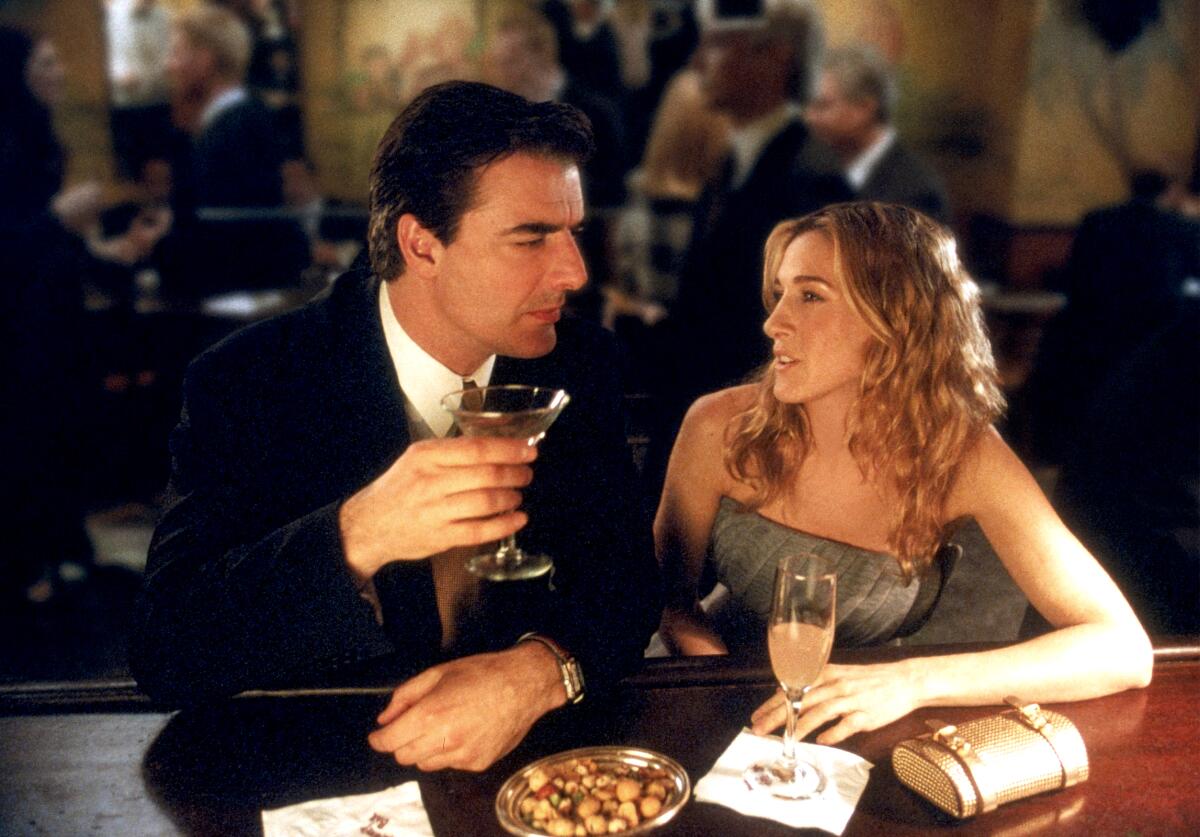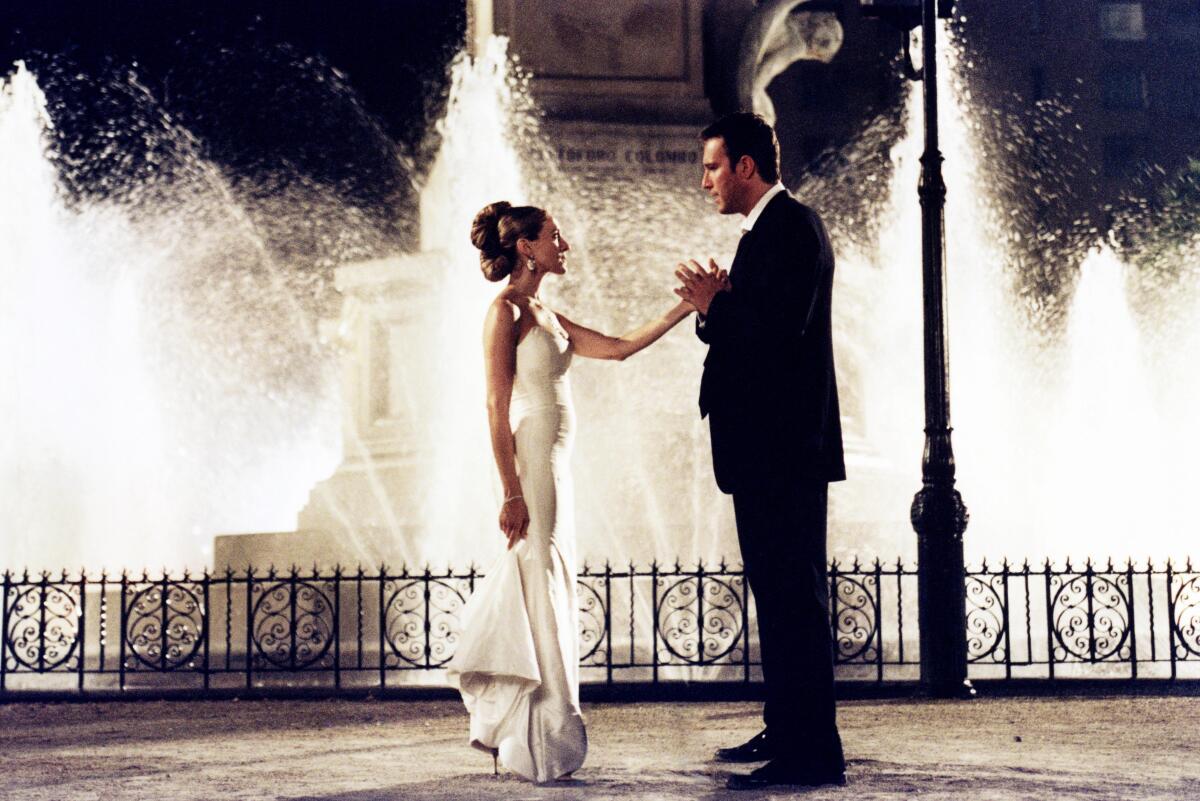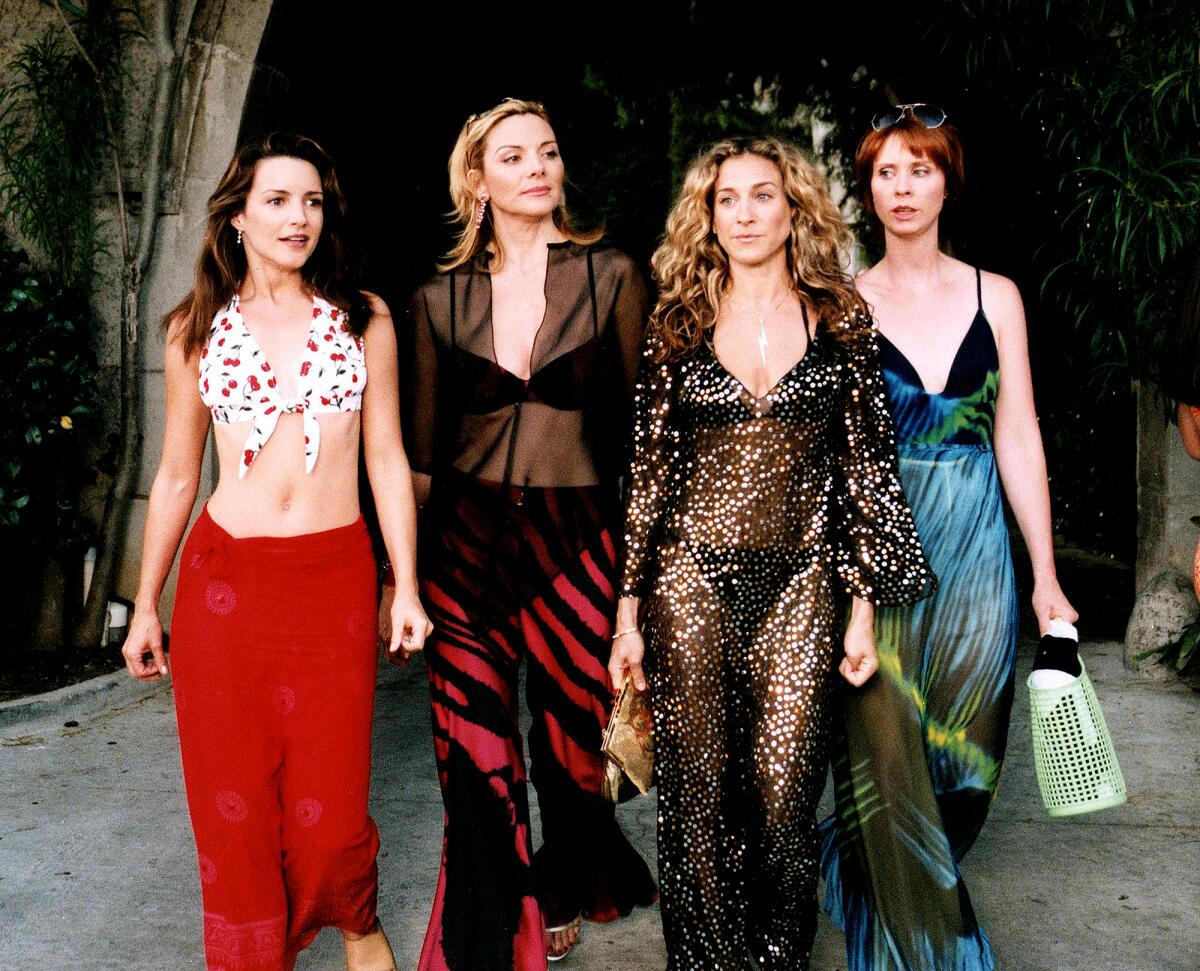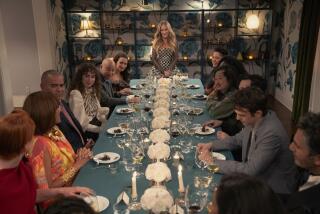Toxic Masculinity and Big vs. Aidan: How ‘Sex and the City’s’ love triangle has aged

- Share via
Ballet flats, low-rise jeans and Cosmopolitans are back in style, so it is the perfect time for all six seasons of “Sex and the City” to stream on Netflix. The HBO series, previously exclusively on Max, premiered April 1 on the streaming service, where a wider subscriber base pulled in first-time viewers and rewatchers who are ready and willing to share their thoughts on social media.
This week, there has been increasing buzz about one of the iconic episodes in the series, when Carrie Bradshaw invites Mr. Big, the ex-boyfriend with whom she cheated on current boyfriend Aidan, to the latter’s cabin.
I couldn’t help but wonder — does Carrie Bradshaw’s Big-versus-Aidan love triangle still feel relevant?
When it first premiered in June 1998, “Sex and the City,” an adaptation of Candace Bushnell’s newspaper column and book, broke a lot of barriers with its depiction of four single women in their 30s and 40s navigating their friendship and vibrant sex lives in NYC. (It also fell short in myriad ways, namely in how incredibly white, heteronormative and privileged the characters were. While some of this changed in Max’s “And Just Like That...,” for the purposes of this essay, I’m just focusing on the original series, not the films or subsequent spinoff.)
It’s been common parlance to declare people specific archetypes promulgated by the show either via the four main friends — Are you a Carrie or a Samantha? — or by the type of love interest one embodies — Is he your Mr. Big or your Aidan?

In particular, when it comes to Carrie’s love interests, both men were pretty flat characters. Big is the stereotypical wealthy, charming playboy with serious commitment issues who just needs the right woman to come along and “fix” him. Aidan, in contrast, is the stable, Hallmark Christmas movie boyfriend who would love nothing more than to get married and stay home eating fried chicken — but he can skew boring.
The bad boy-versus-nice guy trope is a staple of mainstream ’90s rom-coms. Millennials were raised on a diet of toxic, patriarchal relationships on film and TV, where male characters spend the majority of their time treating female characters horrendously and then redeem themselves in the final 20 minutes with one grand gesture. We became a generation trained to wait for our Bigs to catch on to their mistakes, come down the street in a shiny limo and beg our forgiveness. If he hasn’t come back and repented, it’s only because it isn’t our last 20 minutes yet.
But does that trope still work in 2024? I’ve spoken with friends of mine — die-hard Big fans who cheered from our sorority house living room when he showed up at Carrie’s Paris hotel in the 2004 series finale — who are now rewatching the series and wondering why they were so hung up on Mr. Big in the first place. This sentiment has been echoed on social media, with viewers who are rewatching asking if Big has always been this infuriating. Is it just because millennials, now in their 30s and 40s, are at a more stable life stage where we can look back at Big as the walking, talking embodiment of a red flag? Or has society itself shifted away from the Mr. Bigs of the world?
Well, as it turns out, both things can be true.
“In your 20s, your life stage is about searching for identity and collecting experiences. Big was exciting because he was giving Carrie all of these new experiences,” says Israa Nasir, a mental health therapist who treats millennials and Gen Z adults going through life transitions. She says when she first watched the show, she remembers thinking Big was amazing. “But in your 30s and 40s you’re in a different life stage developmentally, you’re more about finding roots. Millennials are rooting down, we’re looking for stability. We can look back at Big and be like, ‘Big was a huge red flag, because he couldn’t give her stability, which is required to move through the life stages.’”
This stability versus excitement is a conversation topic in Season 3, Episode 7, called “Drama Queens.” Over brunch, Carrie tells her friends she’s been waking up in the middle of the night sweating because she’s so anxious about the fact that everything with Aidan has been going so well.
“I’m used to the hunt, and this is effortless,” Carrie says. “You’re not getting the stomach flip,” adds Samantha. “Which is really just the fear of losing the guy,” says Miranda, ever the pragmatic one. Carrie admits she’s not used to being with someone who doesn’t do the “ever-seductive withholding dance.” When Miranda says she’s comfortable and safe and happy with Steve, Carrie deadpans, “Are you dating a man or a minivan?” Samantha tells her, “Your relationship is my greatest fear realized.”

Nasir says that there is a generational difference in how we are engaging with romantic relationships, just by virtue of the world changing and an increase in emotional literacy.
“A 25-year-old current Gen Z person has way more access to self-help content, personal growth, self-awareness, all of those things that help you define yourself and relationships, versus a 25-year-old millennial in the mid-2000s who did not really have that,” says Nasir.
“Millennials inherited a very patriarchal system. Many of us are entering the space of self-awareness for the first time whereas Gen Z is already there so their expectations from a relationship are very different.”
Nasir adds that Gen Zers have changed the gender dynamics of dating. They are much more fluid when it comes to identity and sexuality, they’re more open to polyamory, and they don’t engage in the same debates about who pays, who initiates sex, etc. — themes that are a large part of “Sex and the City’s” plotlines. She says when speaking with her Gen Z patients about relationships, she often thinks about the episode where Miranda bluntly tells two young women that maybe “he’s just not that into you.” It was met with horror when Miranda said that, but Nasir said that kind of factual, upfront, candid conversation is par for the course among the younger generations.
‘Sex and The City’ is now on Netflix, allowing younger audiences to discover the hit show. Many are taking issue with Sarah Jessica Parker’s iconic character Carrie.
In Nasir’s opinion, society hasn’t replaced patriarchal archetypes, we’ve just added more to the spectrum. And even though there are still a plethora of heteronormative love triangles and television often still adheres to the status quo, nuance has crept in. In Netflix’s “Never Have I Ever,” she points out that the lead love interest, Paxton, is the popular guy but with a sensitive side. Nasir says she sees more of an emphasis on platonic love, an expansion of what a long-term soulmate relationship can be, as depicted in series like “Grace and Frankie” or “Insecure.” She compares it with how the archetype of the woman on television changed and expanded from the ‘50s to the ’90s. “From the ’90s to the 2020s, there are more types of relationships that you see. We continue with every generation to add to the baseline,” Nasir says.
Suzanne Leonard is a professor of race, gender and sexuality studies at Simmons University in Boston. “We’ve been in a long, 20-year process of undoing the allure of Mr. Big,” says Leonard, adding that she doesn’t know whether the storylines on television have changed as much as the viewership has. “Audiences are much more aware of the dangers of toxic masculinity, and that doesn’t read as sexy anymore. I think you have more sophisticated feminist viewers.
“It’s sort of seeing what was actually right in front of us the whole time, but we couldn’t see it,” she adds. Leonard partly attributes this shift in our views of romance, this fatigue around brooding, emotionally unavailable characters, to the post-#MeToo moment. (She also points out that Chris Noth, the actor who played Big, was accused by several women of sexual abuse.)
“Male power and male violence has been so sexualized and romanticized, and in the ’90s and early 2000s, heterosexual women were really encouraged to be attracted to that type,” says Leonard. #MeToo created an awareness and reckoning with toxic masculinity that forced people to realize that what society pushed as alluring might in fact be red flags.
Our emotional vocabulary around these kinds of relationships also has shifted, as therapy-speak infuses our everyday language. Twenty years ago, we didn’t say someone was “toxic” or “gaslighting” or “love bombing.” “It has been able to give us labels to very normal human experiences,” says Nasir. And when you can identify these experiences, you can manage them better by naming them and walking away.
Last week when “Sex and the City” hit Netflix, there was buzz around how Gen Z would react, with some (correct) predictions that the “Carrie is the toxic villain” debate would ramp up as it did when “And Just Like That...” aired. “Carrie is the worst human being I have ever seen,” said one first-time watcher. (In contrast, pop star Olivia Rodrigo proudly wore a “Carrie Bradshaw AF” shirt while performing in New York on April 5.)
Right on cue, first-timers began to react to the love triangle storyline on X, formerly Twitter, and TikTok, expressing how upset they were about the Carrie-Big-Aidan triangle. “Now why would Carrie cheat on Aidan with Mr.Big!” tweeted one viewer. “Personally I think Carrie Bradshaw should’ve been court-martialed for inviting Big to Aidan’s cabin,” wrote another.
Then the “Carrie Is Aidan’s Big” discourse began. It’s a debate that felt familiar — was Aidan pathetic for saying he didn’t feel comfortable with her being friends with Big after she had an affair, or was he just setting boundaries? When he agreed to get back together with her, should he have wholeheartedly trusted her and dropped his identity as the victim? Or was Aidan trying to change Carrie into something she wasn’t, and their lifestyles never really would have meshed anyway? And it wasn’t all anti-Big arguments. Did she belong with Big, so they could be toxic together? And there was perhaps the most cutting tweet of all: “Carrie deserved that post-it.”

Pop culture historian Jennifer Keishin Armstrong wrote the book “Sex and the City and Us,” and says she’s always hated Carrie and Big together. “Mr. Big does not come around in the end; that’s the point of your Mr. Big,” says Armstrong, adding that Carrie shouldn’t end up with either of the two men. She is of the mind that Big was terrible for Carrie, but Carrie was terrible for Aidan.
“Television is trying to reflect real life, but it’s hard to get TV out of your head while you’re living your life,” says Armstrong. “This is part of why Mr. Big and Carrie ending up together upsets me because I think it gives false hope when most relationships like this one do not have a happy ending in real life.” (For what it’s worth, the real Carrie agrees.)
Armstrong says the gold standard on TV is now two people with a real friendship who also are attracted to each other. She sees “The Office’s” Jim and Pam as an influential model of this kind of love.
“I do think relationships have gotten more nuanced than they were in the early 2000s,” she adds. “If we look at the TV side of things, think of ‘Fleabag’, whose entire finale is predicated on a very complex, romantic relationship that doesn’t work out the way we’re hoping in our soul, and it’s beautiful.”
It’s hard to imagine how groundbreaking it would have been to have Big and Carrie’s last conversation be them acknowledging their love for each other but promising, “It’ll pass.”
In the series finale, Carrie has a final message about how the most important relationship is the one you have with yourself — but this message is undermined by the fact that this is also the moment she looks at her phone, and for the first time in six seasons, we find out Big’s real name.
I propose an alternate, healthier ending for Big and Carrie — and it already exists in canon. It’s in Part 1 of the series finale, when she confronts Big for boomeranging back into her life right when she’s moving on.
“You do this every time,” Carrie tells Big. “Every time! What, do you have some kind of radar: Carrie might be happy. It’s time to sweep in and s— all over it?”
Big tells her he made a mistake and insists “it’s different this time,” but Carrie interrupts him to say she is done.
“You can drive down this street all you want,” she says, throwing his signature move back in his face. “Because I don’t live here anymore.”
More to Read
The complete guide to home viewing
Get Screen Gab for everything about the TV shows and streaming movies everyone’s talking about.
You may occasionally receive promotional content from the Los Angeles Times.







